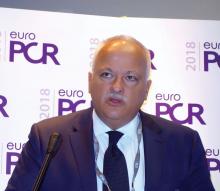PARIS – A strong tide has turned in favor of early percutaneous coronary intervention in patients with stable coronary artery disease, with the proviso that they must display objective evidence of hemodynamically significant stenosis as demonstrated by measurement of fractional flow reserve (FFR) or instantaneous wave-free ratio (iFR).
Indeed, the consistent results of multiple studies presented at the annual meeting of the European Association of Percutaneous Cardiovascular Interventions prompted the meeting organizers to issue a formal summary statement.
“PCI results in less angina, better quality of life, less urgent revascularizations, and less spontaneous MIs compared to medical treatment alone. The longer the observation period is, the more benefit is shown for PCI,” declared Michael Haude, MD, president of the European Association of Percutaneous Cardiovascular Interventions and a cardiologist at Heinrich Heine University in Düsseldorf, Germany.
“” on the basis of the latest studies featuring a contemporary approach, said Dr. Haude, noting that most prior studies of PCI versus medical therapy alone did not use latest-generation drug-eluting stent technology, featuring thin struts, improved antirestenosis drugs, and better drug-release technology and kinetics.
Among the persuasively positive studies presented at EuroPCR 2018 were the 5-year outcomes of FFR-guided PCI versus medical therapy alone in the FAME 2 trial, a secondary analysis of the controversial ORBITA trial, which placed early PCI for stable CAD in a more favorable light than initially reported, and an analysis from the comprehensive national Swedish Coronary Angiography and Angioplasty Registry (SCAAR).
These and several other studies presented at the conference conveyed a consistent message that early PCI in patients with stable CAD and physiologically significant coronary lesions results in improved clinical outcomes and symptomatic relief compared with medical management alone. Conversely, in patients without objective evidence of potentially reversible ischemia based on FFR or iFR, there is no reason to expect benefit from revascularization.
FAME 2
Panagiotis Xaplanteris, MD, PhD, of the Cardiovascular Center at Aalst, Belgium, presented the final 5-year follow-up of FAME 2 (the Fractional Flow Reserve versus Angiography for Multivessel Evaluation 2) trial, in which 888 patients with stable CAD and at least one hemodynamically significant coronary stenosis as defined by an FFR value of 0.80 or less in a major artery were randomized to FFR-guided PCI plus guideline-directed medical therapy or to medical therapy alone.


